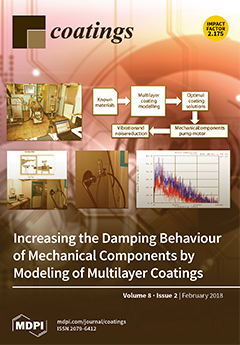In the current work, the microstructure, hydrogen permeability, and properties of chromium nitride (CrN
x) thin films deposited on the Inconel 718 superalloy using direct current reactive sputtering are investigated. The influence of the substrate bias voltage on the crystal structure, mechanical,
[...] Read more.
In the current work, the microstructure, hydrogen permeability, and properties of chromium nitride (CrN
x) thin films deposited on the Inconel 718 superalloy using direct current reactive sputtering are investigated. The influence of the substrate bias voltage on the crystal structure, mechanical, and tribological properties before and after hydrogen exposure was studied. It was found that increasing the substrate bias voltage leads to densification of the coating. X-ray diffraction (XRD) results reveal a change from mixed fcc-CrN + hcp-Cr
2N to the approximately stoichiometric hcp-Cr
2N phase with increasing substrate bias confirmed by wavelength-dispersive X-ray spectroscopy (WDS). The texture coefficients of (113), (110), and (111) planes vary significantly with increasing substrate bias voltage. The hydrogen permeability was measured by gas-phase hydrogenation. The CrN coating deposited at 60 V with mixed c-CrN and (113) textured hcp-Cr
2N phases exhibits the lowest hydrogen absorption at 873 K. It is suggested that the crystal orientation is only one parameter influencing the permeation resistance of the CrN
x coating together with the film structure, the presence of mixing phases, and the packing density of the structure. After hydrogenation, the hardness increased for all coatings, which could be related to the formation of a Cr
2O
3 oxide film on the surface, as well as the defect formation after hydrogen loading. Tribological tests reveal that hydrogenation leads to a decrease of the friction coefficient by up to 40%. The lowest value of 0.25 ± 0.02 was reached for the CrN
x coating deposited at 60 V after hydrogenation.
Full article





